Spend a few nights in Amsterdam’s hip new floating neighborhoods and taste the latest in European culture and lifestyles.
From the Dutch Golden Age in the 17th century until the 1970s, the harbor islands off the eastern coast of Amsterdam were teeming with dockworkers, cargo ships, huge ocean steamers, cranes, and warehouses, while shipbuilders and trading companies were involved in business with the Dutch East Indies and other areas. Then, in the early 20th century, passenger ships filled with European emigrants en route to the Americas sailed from these Oostenlijk Havengebied, or Eastern Docklands.
Towards the end of the 20th century, the area had become outdated and the water too shallow to handle modern vessels, so it was abandoned by shipping companies for more up-to-date facilities established on the west side of town, near the North Sea Canal. During the 1970s, Amsterdam’s 140 acres of deserted docklands became a haven for artists, as well as squatters and drug dealers who moved into the dilapidated warehouses.
At the same time, due to a shortage of housing in Amsterdam, the city was losing large numbers of middle income families who were seeking space to raise their children and, in the 1980s, plans to transform the Eastern Docklands into a new urban center were launched. This very successful urban planning and renewal project has given birth to a unique, trendy area called Nieuw Oost (New East) by the locals. And, these neighborhoods offer visitors to Amsterdam even more to explore.
New Neighborhood in the Eastern Docklands
Four islands and two peninsulas, each with a different flavor, comprise the vibrant new communities that provide over 8,000 residences. By commissioning and retaining architects whose vision and talent are diverse, the homes range from small canal houses to large buildings, each with their own style. On one street of Borneo-eiland, owners of the 60 individual plots of land were encouraged to employ innovative architects, and even though the plots are identical, the homes are amazingly diverse. Throughout the islands, the new residences differ in materials, color and design, and they are also varied in size and price, providing both “social” (government subsidized) and private housing for a variety of families. As in the rest of the city, foot bridges play an important role. On the Eastern Docklands, whimsical, unusual, and uniquely designed bridges join the islands to each other and to the mainland.
The residents of the Eastern Docklands are largely professionals and artists who enjoy the urban lifestyle and creative atmosphere. Surrounded by local street art, lots of green space and water (of course), the apartments, houseboats and garden flats are filled with growing families who are happy to be able to remain in Amsterdam. Vacationing families will especially delight in an opportunity to live the local lifestyle.
Visitors to the islands have several ways to get there from Central Station. Besides a brisk walk (under one-half hour), you can take Bus #42 or Tram #26, or a ferry from Pier 8 behind the station. Guided boat tours are available from Rederij Lovers (+31 (0) 20 5301 090). Walking tours can be arranged through Arttra (+31 (0) 20 0259 303) and Bakker & Bakker (+31 (0) 20 6836 359). Or, you can explore on your own via foot or bicycle with a helpful guide published by ARCAM (Amsterdam Centre for Architecture).
There are several cool shops (and more to come, I’m sure) where it’s fun to browse. Check out one of the six Sissy-Boy Homeland locations in Amsterdam for hip clothing and shoes as well as furniture and accessories, Pol’s Potten (+31 (0) 20 4193 541), located in a former cocoa bean warehouse, for home and garden accessories and Keet in Huis (+31 (0) 20 4195 958) which sells everything for hip and trendy babies, toddlers and children. Many cafes and restaurants, some offering live music performances, line the streets overlooking the water.
Seeing & Doing All Things Nautical
While on the islands, you can visit NeMo (Oosterdok 2, +31 (0) 20 5313 233) a fabulous building designed to look like a ship’s bow, where hands-on activities teach visitors about the sciences and technology with a “Please Touch Everything” approach. With four floors, the exhibits cover many fields of science, technology and engineering and demonstrate how they influence daily life. NeMo welcomes all ages, but their target audience is 4 to 16-year-olds, and their parents. Also, if you visit around lunch time there are numerous cafes within NeMo or if its a nice day you can even pack a picnic to enjoy with your family out on the terrace.
The Post CS Building, an old postal sorting center at Oosterdokskade 5, is the temporary headquarters of Stedelijk CS (+31 (0) 20 5732 911), featuring works from Amsterdam’s renowned Museum of Modern Art, which is temporarily headquartered here while its own building at the Museumplein (Museum Square) is undergoing renovation and expansion. (The Stedelijk CS is expected to return to its original home in early 2009). Plan to stop at the museum’s shop for art books, postcards, posters, jewelry and other interesting items.
The Sheepvaarmuseum (Kattenburgerplein 1, +31 (0) 20 5232 222) located in the 350-year-old former headquarters of the Dutch Navy, is devoted to sailing and international trade history. A replica of the Dutch East India ship The Amsterdam is moored outside the museum and a dramatization of life aboard this vessel is presented by costumed actors. [Editor’s Note: On January 8, 2007, the Netherlands Maritime Museum closed its doors for renovations. Although it should take nearly two years to complete, once it reopens, the museum will be completely refurbished and will be able to accommodate the recent increase in visitors, provide easier access to exhibits and also allow the building to have climax control.]
The Muziekgebouw (Piet Heinkade 1, +31 (0) 20 7882 010) is a fairly new concert hall offering classical and contemporary music, jazz, electronic and non-western music, musical theatre, opera and dance.
If you’re not prepared to sail away to the Docklands, don’t miss a chance to experience it on a Holland International Canal Cruise (+31 (0) 20 625 3035). Their 90-minute “I Amsterdam” cruise tours the latest happenings in the Eastern Docklands with two English language guided departures daily. This company also offers the more traditional canal tours in the historic center of the city, but families can do some of this cruising on their own, by hopping on a Canal Bus, the public ferry system that departs from the Central Station and sails throughout the city.
Details, Details
The Lloyd Hotel (+31 (0) 20 5613 636), on the island named Oostelijke Handelskade, dates from 1921 and has had a unique past, serving first as a hotel for emigrants waiting to board steamships, later as a prison, and then a detention center for juveniles. Currently, the 117 rooms showcase Dutch architecture each with its own edgy style, and range from one to five stars depending on size. Designed to use the space in unconventional ways, the rooms I saw were inventive, and certainly unusual. For instance, in some accommodations the bathroom is in the middle of the room (which also works to offer some privacy for parents and children), one room features a large concert piano, and a few rooms have one huge bed which can accommodate seven people! Some families will find these spaces exciting, but try to get a really good idea of the room before you reserve. The hotel offers one restaurant appropriately named Snel (brisk), a kitchen area if you want to prepare a meal or snack, a small grocery and a library. Family-sized rooms run between €200 and €300.
Another option for unusual lodging is onboard the Amstelbotel (+31 (0) 20 5210 350) moored at Oosterdokskade 2-4. Its location in the heart of Amsterdam makes it just a short walk from Central Station and all other main attractions. This floating hotel with 176 rooms (or cabins) offers a canal view and land view rooms with rates under €125 and is functional, if not fancy, and fun for young sailors.
Finally, in summer bring along a towel and join the residents of the Oostenlijk Havengebied in swimming in the waters surrounding the islands. Jump right off from the land, or, if you’re more adventurous, note that many kids enjoy jumping from the footbridges, one of which is tall enough for ships to pass under.
Dear Reader: This page may contain affiliate links which may earn a commission if you click through and make a purchase. Our independent journalism is not influenced by any advertiser or commercial initiative unless it is clearly marked as sponsored content. As travel products change, please be sure to reconfirm all details and stay up to date with current events to ensure a safe and successful trip.

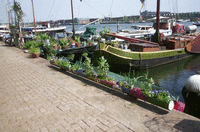
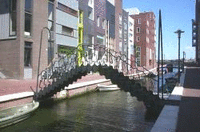

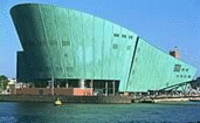
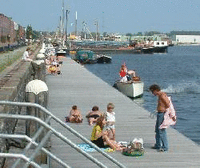

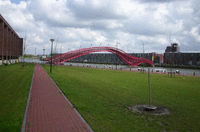
Excellent overview of a very un-touristy part of Amsterdam
I've heard that this housing development project has made Amsterdam city living more affordable for young families. What a wonderful way to keep a very old urban center alive.